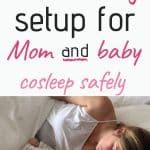Like many first-time parents, I was totally clueless when I came home with my first baby. I had at least done enough research expect to not get a lot of sleep, but I had no idea what reality would be like. Little did I know our baby would be co sleeping with us!
My husband and I had made a beautiful nursery for our little girl, but we also had a bassinet in our room. We figured she would stay in that little crib for a few weeks and then we’d get her used to sleeping in her own room. Ha!
The first few weeks weren’t bad. I was still drenched in new-mom hormones, so whenever my daughter woke up to eat (we were feeding on demand like newborns need), I’d dutifully get up, take her to the rocking chair in the corner of our room, feed her, and then put her back in her bassinet. And my husband was good enough to even wake up with me and chat quietly with me to keep me awake!
But of course, that pattern didn’t last forever. My husband had to go back to work and couldn’t afford to stay up with me. Our baby wouldn’t fall back asleep on her own! I would bounce her and sway her and do everything I could, but as soon as I put her down she would wake up and fuss.
Disclosure: This article contains affiliate links. As an Amazon Associate I earn from qualifying purchases. You can read my full policy here.
So we had to find a new way to make things work. That’s why we (and many other parents) ended up bed sharing with our baby. Of course, my kids’ safety is absolutely top priority, so I did a lot of research before I allowed myself to co sleep with baby. And now I’m sharing what I learned with you.TL;DR? Only bed share with your baby if you are exclusively breastfeeding. Under no circumstances should you sleep on a sofa or in an armchair with your child, and never co sleep with a baby if you are alcohol- or drug-impaired. You should use a firm mattress when co-sleeping – click here for a list of the safest non-toxic mattresses for co-sleeping. The cuddle curl position is safest for co sleeping with baby.
Table of Contents
Why co sleeping is important
Babies are made to sleep with their mother (just like other primates do). Until the early 20th century, bed sharing was the norm in Western countries (and still is in many places today).
For the nine months before birth, mother and baby are literally as close together as possible, all the time. Baby was constantly in contact with mother’s heart rate, breathing, and more. The mother’s pregnant body did a lot of work to regulate the baby’s physiology.
Once a baby is born, he still needs help with regulating immature body systems to control breathing patterns, body temperature, heart rate, and more. The close contact from co sleeping allows the mother to help regulate these systems.
How many people co sleep with their baby?
More people bed share with their baby than you’d think, and definitely more people co sleep than will admit it.
Here’s the deal: Whether you exclusively breastfeed, formula feed, or do a combination, your baby is going to be waking up in the night a lot, and you’re going to be desperate for sleep. In fact, studies show that exclusively breastfeeding mothers actually get more sleep than their formula-feeding counterparts!
But we’ve all heard the horror stories and seen the scary ads about SIDS, so we think we’re not “supposed” to sleep with our babies. But we’re so tired, it feels like the only way to survive. So we put our babies in bed with us.
Want proof that you’re not the only one? Dr. Kathleen Kendall-Tackett, a maternal-child sleep expert, explains.
According to her research on maternal-child sleep, babies often start the night in their own room or in a crib in their parent’s room. But somewhere in the middle of the night, over half of babies, regardless of age, end up in bed.
Tragically, the fact that we don’t educate parents in the States on how to co sleep safely potentially leads to more dangerous practices.
We don’t wear seat belts because we plan to crash, we do it just in case. So why don’t we just teach people how to bed share with their babies safely, in case that ends up happening?
Check out this interview with Dr. Kendall-Tackett for more on her take about parent education on co-sleeping:
Bottom line: Even if you don’t plan to co sleep with your baby, you should at least learn about how to do so safely in case it ends up happening.
Co sleeping with your baby: Potential dangers
Many of us have seen the billboards: “You wouldn’t let your baby sleep with a knife, so why would you let him sleep in your bed?”
The big worry, of course, is SIDS. The threat of this tragedy strikes more fear into new parents than perhaps anything else. And we have been taught that bed-sharing can lead to SIDS.
Co sleeping on sofas and recliners
Many times, it’s not bedsharing that is associated with this devastating outcome, but co-sleeping on another piece of furniture.
For example, sofas and recliners are extremely dangerous to fall asleep on with your baby. Once a parent falls asleep, it is easy for babies to get lodged between cushions and be unable to breathe.
The real tragedy of this situation is that mothers who are in an armchair or on a couch with their child probably have no intention of falling asleep there. It’s just so easy to do when you’re so exhausted! So if you need to rest in the night while feeding your baby, you are better off getting in bed with her than getting on a couch or in a chair.
Cosleeping dangers in bed
Additionally, a bed can be safe, but not if there’s heavy comforters, puffy pillows, or a soft mattress. These articles can obstruct a baby’s airway.
And if a parent is influenced by alcohol or drugs that could cause extra drowsiness, they should not be in bed with their baby. In this state, you’re less likely to notice if you roll over on your child.
On a similar note, SIDS is more likely when a baby is asleep with other children or a pet. Siblings aren’t as likely to notice a baby and move away in their sleep as a parent is. So don’t leave your children sleeping with their baby sibling.
The benefits of co sleeping
At the same time, there are many benefits of co sleeping with your baby.
The main benefit?
You’ll get more sleep!
I know “they” tell you to put your baby in her own crib, still drowsy, and let them go to sleep without you, and some babies allow that (my second was okay with it). But others, like my oldest, just won’t have it. That’s what makes co sleeping essential for some of us!
Assuming you’re breastfeeding, your baby will stir and you can lean over and feed from a side-lying position, still in bed. Then you can both easily go back to sleep. The awesome thing is that this trick works whether your baby is directly in bed with you, or she’s in her own little side car like this one.
RELATED: The best non-toxic co sleeper bassinets
Co sleeping helps with breastfeeding success.
On top of that, bedsharing with your baby makes it more likely that you’ll be successful at keeping breastfeeding up. Co sleeping babies spend more time nursing at night (but with less sleep disturbances!), and the extra suckling helps to ramp up milk supply in mothers. Win-win!
RELATED: Newborn breastfeeding – 12 tips
And although we hear a lot about SIDS and bedsharing, breastfeeding is one of the best ways to decrease the risk of SIDS. Since co sleeping supports breastfeeding, if it’s done safely, it can actually decrease SIDS risk as well.
You’ll get to wake up to your adorable baby
Not to mention, there’s nothing more precious than waking up to your baby cuddling you and smiling at you. Such sweet memories 🙂
RELATED: 45 Encouraging breastfeeding quotes

How do you make bedsharing safe?
Done incorrectly, yes, bedsharing absolutely can be dangerous. But with the right precautions, it can be a wonderful arrangement for mother and baby.
One of the best tools for knowing how to bedshare safely is the “Safe Sleep 7.” This information is put out by La Leche League, an international breastfeeding support group (who also published this book that absolutely made the difference in my successful breastfeeding journey!). I’ll recap here and add my own experience.
If you choose to bed share:
1. No smoking!
Whether you do so in bed or out of bed, bedsharing when you’re a smoker is a big no-no.
Incidentally, parents who smoke significantly increase their child’s risk of SIDS, as well as a whole host of future problems for their child. If this is something you struggle with, get help.
2. No alcohol or other mind-altering drugs
Even when you’re asleep, you’re aware of your environment. After all, you almost never roll off the bed, right?
But this awareness is impaired when you’re intoxicated. So don’t drink and then co sleep.
3. Exclusively breastfeeding is better.
Breastfeeding is protective of SIDS. On top of that, some studies have shown that women who breastfeed their babies tend to lie in a cuddle curl position around them and wrap their arm above them, thereby blocking the baby’s head from pillows.
RELATED: Advantages of breastfeeding

Formula feeding babies, on the other hand, tend to sleep with their head up at pillow height, where there is more danger of smothering. So it’s strongly suggested that only exclusively breastfeeding babies bedshare.
At the same time, the logic from before still stands. Regardless of feeding method, if you have to get up in the middle of the night with your baby, you’re safer taking him to bed with you than going to a couch or recliner!
4. Your baby should be healthy and not a premie.
Especially small babies should not bed share.
5. Your baby should sleep on his back.
This tends to happen naturally with bedsharing, breastfeeding babies. They may roll towards you, onto their side, to nurse, and after getting done they’ll roll back onto their back.
Alternatively, they may stay on their side towards you. That’s okay too.
6. Your baby shouldn’t be allowed to overheat.
Being too warm (to the point of sweatiness) is another risk factor for SIDS.
If you think your baby is going to have your top sheet over her, he shouldn’t have very heavy jammies on (you shouldn’t have any heavier blankets over her). Otherwise, a thinner sleepsack will do the trick.
Side note since we’re discussing sleepsacks here: Don’t swaddle your baby if you’re bed sharing! Those little arms are helpful for alerting you to her presence, so let them stay out. I loved having sleepsacks for all three of mine (especially for naps when I wasn’t in bed with them), but you just have to make sure to undo the swaddle once you bring them into your bed.
UPDATE: I have discovered the Zipadee-zip for my fourth baby and I LOVE it. This little sleepsack allows your baby to have his arms covered without swaddling. Also, your baby looks like a tiny adorable starfish, so there’s that. Definitely go for a Zipadee-zip if you’re co-sleeping.
7. Have a safe surface for your baby to sleep on.
Avoiding sofas and recliners is only the first part of having a safe sleep surface. You need to have a firm mattress that doesn’t allow your baby to sink in.
In addition, you need to make sure the baby can’t roll off into the floor or get wedged somewhere unsafely. Some people choose to simply forego a bedframe and just have their mattress on the ground while cosleeping. Others have the bed directly against the wall (but you have to make sure there’s no gaps between the mattress and the wall).
As I mentioned at the beginning, we had a nursery set up for my firstborn’s arrival. When we had each of our next three, though, we didn’t bother. We knew those babies would be in our room!
Once we wised up, we chose to sidecar my daughter’s crib to our bed. (I love the design of this one. It wasn’t available for our kids, but it’s adjustable to come up exactly to the height of your bed and fit directly against your mattress. This would have made my life so much easier if we had just gotten it instead of a fancy traditional crib).
The sidecar made sure the baby couldn’t roll into the floor. Plus, when she was really tiny and fussed to eat, I could lean over into her crib (weird, but true!), feed her, and then pull away and go back to sleep in my bed. No one had to get up, but she still had her own sleep space. And as she got older (bedsharing risk decreases even further after three months), I had the choice of whether she would be in her little sidecar crib or directly beside me.

UPDATE: We finally sprung for the HALO swivel bassinet for our fourth baby, and I love it! The side raises and lowers so you can get to baby easily in the night, and then you can swivel the bassinet out of the way to get out of bed in the morning. And after crawling down my bed, around a crib for the previous babies, I can tell you that the swivel makes a BIG difference.
If you choose to have your baby directly in bed, you also need to make sure her head is kept clear of pillows. Ideally, you are told to just not use pillows at all. Full disclosure, I have a fairly firm (not billowy) pillow that I use, but I never had an issue with my babies getting too close to my pillow. But that’s up to you.
Choose a safe co sleeping position
Your position when you sleep with your baby is important for safety. Do not sleep with your child’s head up near yours (especially if you choose to keep a pillow in bed).
Instead, cuddle up on your side, facing your baby. Let your baby cuddle against you, with head at breast level. Assuming you follow everything else from the Safe Sleep 7, this is the safest bed sharing position.
Maintaining that cuddle curl position will help keep your baby away from pillows, and they’ll instinctively stay close to you (instead of scooting around and falling).
Is co sleeping or bedsharing for you?
I hope this post has given you a lot to think about concerning the advantages of bed sharing, as well as how to do it safely. If you still need some nursing help, make sure you grab the Breastfeeding 101 guide.
Let me know in the comments if you have any questions and Happy Parenting!








Hello, glad that i saw on this in google. Thanks!
Great post! So thorough! I’m not a parent but I have heard parents express their concern with SIDS. I think many parents will benefit from this post; allowing them to get more sleep and alleviate their concerns of sleeping in the same bed with their babies. Thank you!
Roger Petersen
Mind and Love
Thank you so much Roger! You’re right, so many people are terrified at the thought of SIDS (how could you not be?). But there are definitely ways to keep your child safe while still getting the sleep you need.
Samantha
You wrote a great article! I’m sure it will be really helpful for new parents. Please keep it up. And keep giving us awesome articles like this. God bless you.
Love and Regards
Ethereal Jisun
This is a great article! I wonder if it was possible to ask you some more questions?!
Thanks so much! What have you got?
Just watch the baby doesn’t fall off the bed. So scary. head injuries neck injuries. I am just so scared of this…
That would be scary, Abbie. Yes, that’s why they recommend having your mattress on the floor instead of up on a frame. Thanks!
Do you have any tips for co sleeping safely while traveling? We have our mattress on the floor at home but my husband wants to visit family in Mexico (scorpion country so sleeping on the floor is not an option). I never thought we would co sleep but once our daughter out grew the Snoo I couldn’t get her to sleep through the night any other way. She’s 10 months now and VERY mobile so I worry about her waking up before I do and crawling/falling off an elevated surface.
Oooh, that is tough Mary. I mean, you could sleep with her between you in bed (especially with her being older), just make sure you wake up well enough to keep her from crawling over you and crashing out of bed.
I take a travel bed guard on holiday with us and use it at home too so no need to put mattress on floor. They go flush to the mattress so no gap to fall down and breathable mesh so no risk of suffocation or overheating. Fold up pretty well too.
Great read! Curious about co sleeping with a 4 month old and getting baby to sleep when mommy isn’t there. I co sleep at home but if baby is at the sitter he refuses to sleep also sleep time is greatly reduced without mommy in bed. It’s often accompanied with lots of crying too. Any suggestions on handling this? I know it’s confusing for him but as a single mom I don’t have many choices.
That’s so hard Erika! Unfortunately, it’s recommended that only an exclusively breastfeeding mother bed share with baby because you have specific hormonal changes that make you more attuned to your baby in your sleep.
I found that when my babies were in daycare, they’d go to sleep for them fine but I still needed to lie down with them when we were at home. They’ll often have different routines for different caregivers.
You’re doing great!